Author: Arjun Chand, Bankless; Translator: Tao Zhu, Golden Finance
Artificial intelligence x cryptocurrency is the topic that people are talking about. It is one of the hottest investment themes in this bull market.
Bittensor (TAO) is one of the leading projects in the field of artificial intelligence, both in terms of market capitalization and mindshare. But recently, there has been some stir on crypto Twitter about its practicality, with some people even calling it "steamware" and a meaningless act of decentralization.
But hey, there are always two sides to every coin. While critics have been skeptical of Bittensor and its design, we are focusing on the bright side today.
There are a lot of cool things happening in the Bittensor ecosystem. We will highlight the most impressive subnets and take a look at the DeFi projects that have grown alongside Bittensor and TAO.
About Bittensor
Bittensor aims to democratize the process of building AI-driven use cases by creating an open P2P marketplace where people can share and use machine learning models.
The key idea behind Bittensor is that it forms an interconnected neural network of machine intelligence. Anyone can tap into this network and build subnetworks, which are specialized protocols that use this collective intelligence to power various AI projects.
Currently, there are 32 subnetworks in the Bittensor ecosystem, each focused on a unique use case. Think applications for speech-to-text, image generation, AI-driven search engines, advanced trading strategies, and even fine-tuning Large Language Models (LLMs) for other use cases. The possibilities are endless.
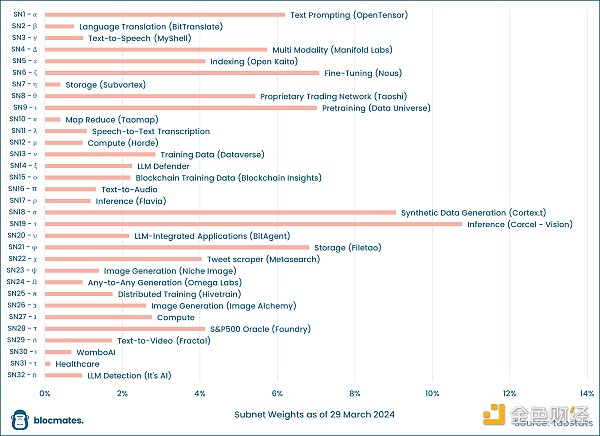
For example, some of the insights in this article come from Corcel, a user-friendly tool for Subnet 18 (also known as the Cortex.t subnet) in the Bittensor ecosystem. It functions similarly to chatGPT, but it uses the collective intelligence of the Bittensor network machine learning models to provide the best response to user queries.
Now, let’s look at some of the standout subnets in the Bittensor ecosystem and their capabilities:
Subnet 6 — System Fine-tuning
Operated by the renowned Nous Research team, Subnet 6 stands out in the Bittensor ecosystem. This subnet specifically leverages synthetic data from Corcel in Subnet 18 to fine-tune Large Language Models (LLMs).
Each miner in Subnet 6 takes the same synthetic data every day and uses it to fine-tune the LLM for a specific result. They employ their own strategies and techniques to achieve the best performance on this data.
The key competitive element is the TAO reward. Miners with lower "head-to-head losses" (meaning they make fewer mistakes) can earn more TAO rewards. This incentivizes everyone to do their best and continuously improve their models to climb the fine-tuning subnet leaderboard.
This approach of using new synthetic data to train miners is an improvement over traditional approaches that rely on static datasets, as the constantly changing synthetic data forces miners to constantly adapt and learn, making them more resilient to real-world scenarios.
Subnet 8 — Proprietary Trading Network
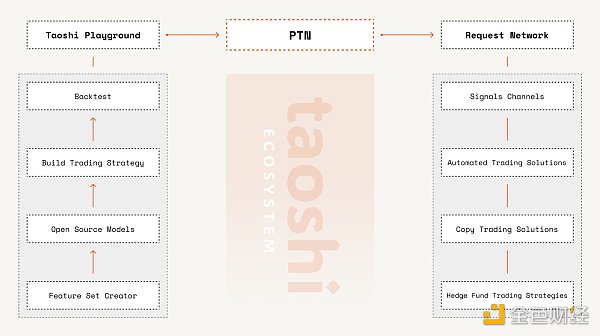
Subnet 8, referred to by τaoshi as the Proprietary Trading Network (PTN), is a competitive playground where top algorithmic traders deploy quantitative models to analyze the market and predict price movements of assets such as BTC and TAO. The best algorithms win rewards in TAO based on their profitability.
Miners who provide valuable trading signals will receive TAO rewards, validators will receive 100% of the revenue from trading signal sales, and users can gain insights that will help them outperform the market.
The fact that SN8 is generating revenue is a major milestone for the Bittensor community, demonstrating that viable businesses can be built on Bittensor. This signal can attract new talent, users, miners, and validators, facilitating the growth and development of the entire ecosystem.
Recently Registered Subnets on Bittensor
As Bittensor continues to grow in popularity, reputable teams across the ecosystem have registered their own subnets on Bittensor. Notable examples include:
Subnet 3, MyShell TTS — dedicated to democratizing access to top text-to-speech (TTS) models.
Subnet 5, Open Kaito — Kaito is committed to making Web3 information universally accessible, aiming to remove barriers and promote collective efforts to organize and interpret Web3’s vast amounts of data.
Subnet 30, WomboAI — home to WOMBO, a very popular app (over 100 million downloads) that augments creativity with AI, turning simple ideas into animated pictures or generating art from a few sentences.
In addition, there are currently over 200 subnets in the testnet waiting to be registered on the mainnet, each with a unique goal and reward structure.
Since the number of subnets in the Bittensor ecosystem is currently capped at 32, competition is fierce, and the lowest performing subnet will be replaced by a new subnet after a week of competition. This competition will only intensify as more and more projects compete to build subnets on top of Bittensor. It will be interesting to see how the subnet landscape changes in the coming quarters.
Having learned about the subnets on Bittensor, let’s move on to the next section of this article — the Bittensor DeFi ecosystem.
Bittensor’s DeFi Ecosystem
The Bittensor DeFi ecosystem is taking shape in real time. Just six months ago, it didn’t exist, but now it already has over a dozen applications offering financial products centered around Bittensor and its native token, TAO.
Let’s take a look at some of these applications:
Tensorplex Stake (stTAO)
Tensorplex offers a product line focused on decentralized AI, built on top of networks like Bittensor. As an active participant in the Bittensor ecosystem, they offer a range of services including Tensorplex Stream, which provides AI-generated summaries for podcasts, Twitter spheres, and news articles. Additionally, they are an active miner on the Bittensor subnet.
One of their products, Tensorplex Stake, launched on Ethereum in February 2024, enables users to participate in staking on the Bittensor network and earn yield (currently over 16%).
Here’s how it works:
Tensorplex Stake allows users to stake their wTAOs, and receive stTAOs in return. stTAOs represent your staked TAOs and track staking rewards.
The underlying wTAO connects to the Bittensor network and stakes with validators, earning yield. This yield is returned to users on Ethereum.
This approach provides a convenient way for users on Ethereum to explore yield opportunities through TAOs without bridging their assets to Bittensor.

TaoPad — Building DeFi for TAO
TaiPad is the first Bittensor-focused launchpad, designed to increase the value of the TAO token and support the broader Bittensor network.
TaoPad’s launchpad enables new projects, especially those focused on decentralized artificial intelligence, to launch through token sales.
TAO is fundamental to the design of TaoPad, here is how it leverages TAO to generate utility:
Reward System - TaoPad distributes rewards to holders in the form of wTAO.
Launchpad Participation - TaoPad Launchpad allows users to participate in the launch of new projects using wTAO. This creates a use case for wTAO and promotes the growth of the Tai ecosystem by introducing new projects. To participate in a project's launch on TaoPad, investors allocate a portion of their $wTAO to the project's funding pool. The more wTAO a user commits, the more favorable pricing they get for new project tokens.
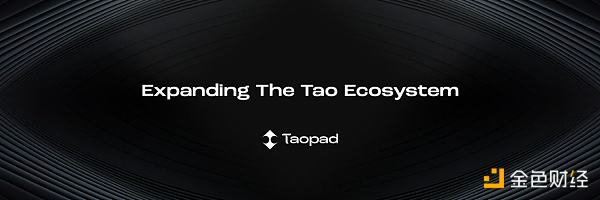
TaoBank
TaoBank is a lending protocol based on Ethereum and Arbitrum. It enables users to use wTAO as collateral to obtain interest-free loans in $taoUSD, a stablecoin soft-pegged to the US dollar designed to maintain low volatility.
For TAO holders, TaoBank provides the opportunity to unlock liquidity in their holdings without having to sell, which is a particularly attractive feature during bull markets. This feature allows DeFi strategies such as looping, where users can leverage their loans to acquire additional TAO.
Interestingly, TaoBank was incubated by TaoPad and was, in fact, the first project to go live on its Launchpad. This is a great example of two Bittensor-centric projects working together to create new utilities for TAO.
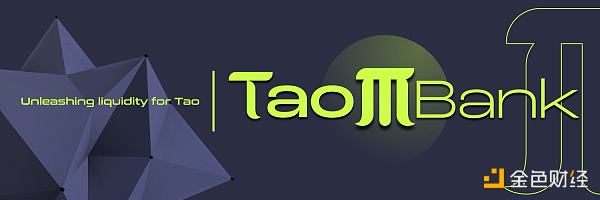
Tao Accounting System (TAS)
TAS is a protocol that brings token standards to the Bittensor network.
The first of many experimental token standards they launched is Tai Request for Comment (TRC-20), similar to the ERC-20 standard in the EVM ecosystem. TRC-20 establishes a unified set of rules for token creation, exchange, and governance on Bittensor, creating a standardized method for anyone to launch a TRC-20 token.
TAS operates as a distributed ledger system that records TRC-20 token balances, stored on their recently registered Subnet 31. Soon, they plan to activate miners and validators on their subnet to keep these records accurate.
Once the TAS subnet is live, anyone will be able to easily deploy and trade TRC-20 tokens on Bittensor.
Currently, users can only participate by purchasing $TAS tokens and staking them to earn yield, benefiting from TAO emissions allocated to the TAS subnet.
In addition, TAS also provides a bridge for users to convert wTAO on Ethereum to tTAO (the wrapped TAO version of TAS), enabling them to transfer them to the Bittensor network or stake them for yield.
RivusDAO — Liquidity Staking for TAO
RivusDAO provides liquidity staking services tailored for AI-centric blockchains, including Bittensor. It introduces a liquidity staking mechanism for TAO through $rsTAO, enabling users to stake their wTAO on Ethereum and in return, receive $rsTAO to accumulate staking rewards.
The vision for $rsTAO is to integrate it into DeFi applications in the ecosystem. For example, rsTAO can be used as collateral on Aave and other lending platforms.
In addition, RivusDAO is developing a bridge to facilitate the transfer of assets from selected blockchains to Bittensor.
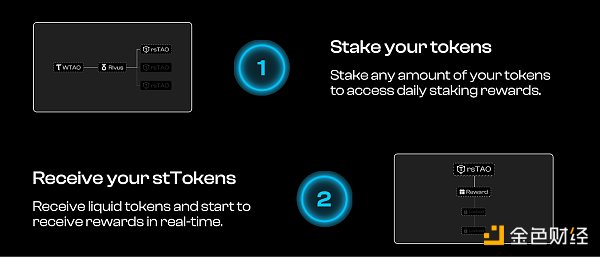
TAO Involves Hyperliquid
Hyperliquid has become the leading perpetual DEX, with a total trading volume of over $100 billion since launch. It provides an excellent user experience for on-chain traders and has become the platform of choice for many traders.
In February of this year, Hyperliquid expanded its product offering by listing $TAO, providing users with the opportunity to open long or short positions on TAO with up to 5x leverage. This addition increased TAO's trading volume.
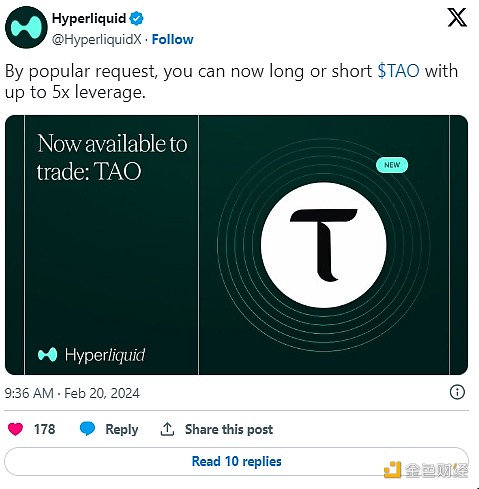
DeFi strategies around TAO in the MultiversX ecosystem
Last month, Hatom Labs launched several DeFi products around TAO in its MultiversX ecosystem, aiming to increase TAO’s utility and integration with DeFi platforms.
The main DeFi features of TAO in the MultiversX ecosystem include:
Liquid Staking – Users can stake their wTAO and receive swTAO, enabling them to earn yield on their staked assets.
Lending — wTAO and swTAO can be lent in various markets. Currently, the annual lending rate for wTAO and swTAO tokens is impressive at 45% and 36% respectively.
LP on xExchange — Users can provide wTAO in the wTAO/EGLD liquidity pool on xExchange.
LP on AshSwap — Users can provide wTAO in the wTAO/USDC liquidity pool on AshSwap.
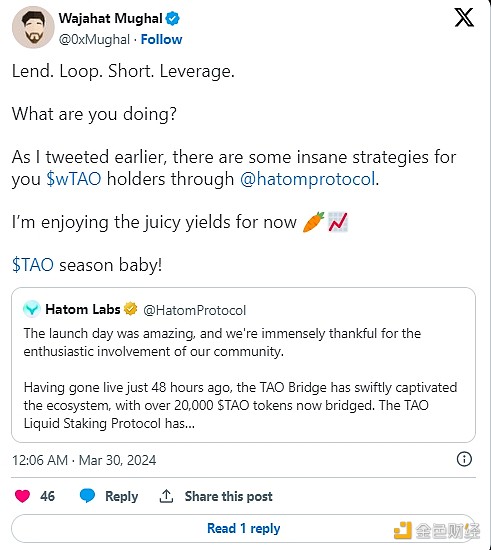
Sturdy AI DeFi Subnet on Bittensor
Sturdy is a lending protocol on Ethereum and Mode that operates as a money market with a two-layer structure, with independent lending pairs and aggregate vaults. These vaults are designed to store multiple loan pairs, aiming to maximize yields and ensure the best interest rates.
Currently, aggregate vaults rely on manual intervention or simple algorithms to decide on deposit allocations, which is both inefficient and centralized. To address these limitations, Sturdy launched a subnet on Bittensor.
On this subnet, miners can propose the best allocation strategy for the aggregate vault and compete with each other to obtain TAO rewards. This way, users can get better rates and the allocation process for aggregators becomes open and competitive.
While this isn’t exactly a DeFi opportunity like the others on this list, it sets a precedent for other DeFi applications to leverage Bittensor to optimize their current offerings. Additionally, applications can leverage Sturdy’s subnets to optimize their operations without having to build their own subnets on Bittensor.
Concluding Remarks
The Bittensor ecosystem is going through a period of growth and evolution. There has been a clear uptick in interest from reputable entities seeking to register subnets, as well as user engagement on applications like Corcel.
The DeFi landscape within Bittensor is also expanding, though it’s still in its infancy, currently featuring liquidity staking, bridges, and a few lending protocols. However, these are the fundamental building blocks of any ecosystem.
Clear signs of adoption, increased DeFi opportunities, and growing interest in subnet registrations suggest that Bittensor may be more than just steaming software.
 JinseFinance
JinseFinance
 JinseFinance
JinseFinance JinseFinance
JinseFinance JinseFinance
JinseFinance Max Ng
Max Ng Cointelegraph
Cointelegraph Cointelegraph
Cointelegraph Bitcoinist
Bitcoinist Cointelegraph
Cointelegraph Nulltx
Nulltx Cointelegraph
Cointelegraph